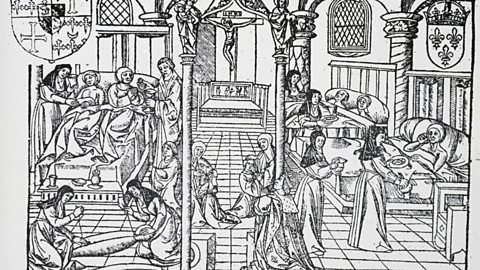The role of the Church and monasteries
The Church played a major role in patient care in the Middle Ages. The Church taught that it was part of a Christianās religious duty to care for the sick, and it was the Church that provided hospital care. The Church also funded the universities, where doctors were trained.

There were about 1,200 places in medieval England and Wales that described themselves as āhospitalsā. Almost all of them were run by the Church. Many were monastery infirmaryA hospital. eg at Strata Florida, Tintern and Valle Crucis. Some were run by other types of religious houses, eg the Franciscan friaries in Bangor and Cardiff.
However, these medieval hospitals were very different from modern hospitals:
- They were run by monks or nuns.
- Patientsā spiritual welfare was considered to be as important as their medical needs.
- The monks and nuns had only basic medical knowledge (though they were probably the best qualified people at the time to do the work).
- Certain people were excluded, eg those with contagious diseases, leperA person suffering from leprosy, a bacterial infection that causes serious damage to the nerves and skin. disabled and mentally ill people. It was felt that they would infect the other people in the hospital.
Medieval hospitals
This chart shows that only about 10 per cent of medieval hospitals cared for the sick in the way that modern hospitals do. They were only called hospitals because they provided hospitality, ie a place to rest and recuperate. Most hospitals were actually almshouseHousing provided by charities for people (usually the elderly) who can no longer provide for themselves. for the elderly and infirm. They provided basic nursing but no medical treatment.
Other hospitals, eg the Hospital of St Thomas the Martyr of Eastbridge, were situated on important pilgrimageA journey which has religious or spiritual significance, usually to an important religious place. routes. They were set up as hostels for pilgrims.
There were also leper hospitals. These were on the outskirts of towns so that lepers could be isolated from the rest of the community. This was because leprosy was a contagious and incurable disease. Leper hospitals gave people with leprosy somewhere to live and get food, but they did not provide any treatment for the condition.
Bimaristans
Medical care by physicians or doctors seems to have been rare in medieval hospitals. There are a few references relating to the provision of medical care at London hospitals in the late Middle Ages. In 1524, for example, the Savoy Hospital (founded by Henry VII in 1505) was expected to have a doctor and a surgeon.
In the Middle Ages, the Islamic world was far ahead of Europe in terms of hospital provision. In the 12th century, Baghdad alone had 60 bimaristans - a Persian word meaning hospital - at a time when London had only one hospital. The bimaristans served all people regardless of race, religion, class or gender, with separate wards for different illnesses - mental disease, contagious disease, non-contagious disease, surgery and eye disease. This was something unheard of in Europe at the time.